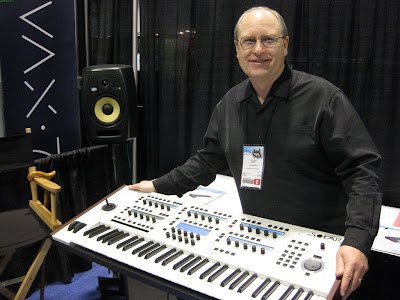
via mark:
"Nova is blowing them out for $1899 on
their site. Won't last long. Get yours today!"
"The MINIMOOG VOYAGER Old School Synthesizer is a monophonic analog performance synthesizer. It has extensive patching facilities, and expanded modulation capabilities.The signal path starts with a bank of three wide-range, high-stability voltage controlled oscillators, one noise source and one audio preamplifier for externally-applied audio signals. The sound modifiers are two Moog filters and one stereo VCA (Voltage Controlled Amplifier).
Control devices include a 44-key keyboard with velocity and afterpressure outputs, pitch bend and modulation wheels and many control/pedal input jacks.The MINIMOOG VOYAGER OS has a hinged, multi-position panel and a solid hardwood cabinet. The power supply accepts any power voltage from 100 volts to 240 volts.
Oscillators Module
Three wide-range, high stability VCO’s (Voltage Controlled Oscillators) with continuously-variable waveforms. * FREQUENCY controls (2) vary the frequencies of Oscillators #2 and #3 over a +/-7 semitone range with respect to Oscillator #1.* OCTAVE selectors (3) set the frequency ranges of the oscillators in six octave steps.* WAVE controls (3) provide continuous control over the waveforms of the oscillators, from triangular, to sawtooth, to square, to narrow rectangular.* 1-2 SYNC switch synchronizes the Oscillator #2 waveform to the frequency of Oscillator #1, for dramatic timbral effects.* 3-1 FM switch provides linear frequency modulation of Oscillator #1 by Oscillator #3.* 3 KB CONT switch disconnects Oscillator #3 from control by the keyboard, thereby enabling it to function as a drone.* 3 FREQ switch lowers the frequency of Oscillator #3 into the sub-audio range, thereby enabling it to function as a low frequency audio or modulating oscillator.
Mixer Module
Five-input mixer for combining the audio sources prior to filtering. * Input Level controls (5) adjust the relative levels of the oscillator, noise, and external audio input signals.* Input switches (5) enable the player to quickly switch individual audio signals in and out.* External Level LED enables the player to set the correct external audio signal level.
Filters Module
Dual mode filter module includes dual lowpass and highpass-lowpass filtering. Dual lowpass mode consists of two Moog lowpass-resonant filters in parallel, one per output channel. Highpass-lowpass mode consists of Moog lowpass filter in series with a highpass filter.* CUTOFF control sweeps the frequencies of both filters throughout the audio range.* SPACING control sets the spacing between the frequencies of the two filters, over a +/-3 octave range.* RESONANCE control adjusts the resonance of both filters, from none (pure lowpass response) to filter oscillation.* KB CONT AMOUNT control sets how much the filters open and close as the player presses different keys on the keyboard.* Dual Lowpass/Highpass-Lowpass switch selects between dual lowpass operation or highpass-lowpass operation.
Envelopes Module
The Envelopes Module generates two wide-range ADSR (Attack Decay Sustain Release) envelopes. The Filter Envelope sweeps the filter and is available for modulation shaping. The Volume Envelope shapes the overall volume.* ATTACK controls (2) determine the attack times of the envelopes.* DECAY controls (2) determine the decay time constants of the envelopes.* SUSTAIN controls (2) determine the sustain levels of the envelopes.* RELEASE controls (2) determine the release time constants of the envelopes.* AMOUNT TO FILTER control determines how much the filter envelope will open and close the filter, from full negative (inverted envelope) to full positive (non-inverted envelope).* ENVELOPE GATE SWITCH selects whether the envelopes will be triggered by the keyboard, on , or by an externally-applied gate.
LFO Module
Low Frequency Oscillator generates triangular, square, Sample & Hold, and smoothed Sample & Hold waveforms for use as modulating signals.* RATE control sets the LFO rate over the range 0.2 Hz (one cycle every five seconds) to 50 Hz (fifty times a second).* WAVE LFO selector selects Triangle, Square or Sample & Hold (Stepped or Smooth) waveforms for use with the Mod Busses. * RATE LED provides visual indication of the LFO rate.
Enhanced Modulation Busses Module
Selects the sources, destinations, and shaping signals for the two modulation busses.* SOURCE selectors (2) selects the modulation source from the LFO, Oscillator 1, Oscillator 2, Oscillator 3, noise or the external modulation input (MOD2).* DESTINATION selectors (2) selects the modulation destination from Pitch, Oscillator 2, Oscillator 3, the filter cutoff frequencies, the oscillator waveforms, or LFO Rate.* CONTROLLER selectors (2) selects the Mod Wheel, MOD1, Velocity, Pressure, Filter Envelope or Volume Envelope to shape the modulation signal on that bus.* AMOUNT controls (2) sets the overall modulation amount for each bus."





















































